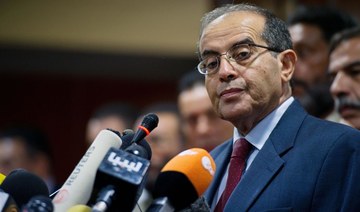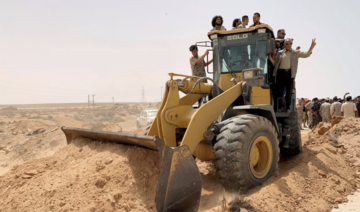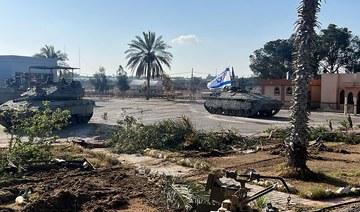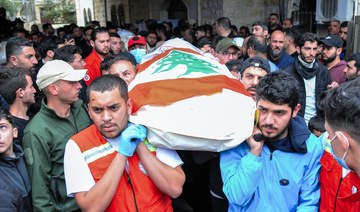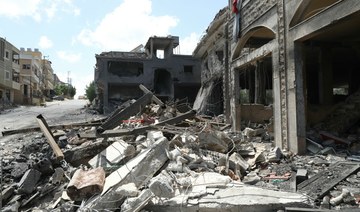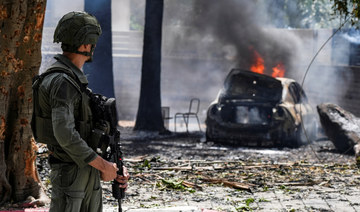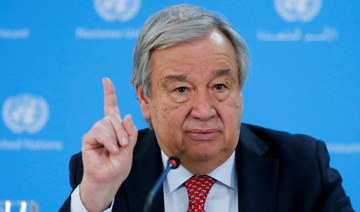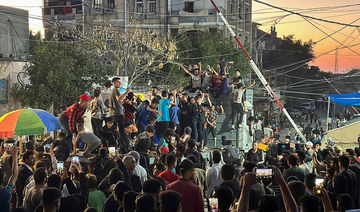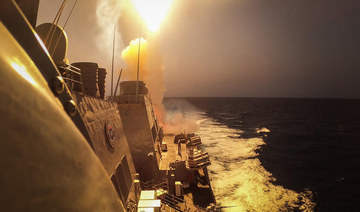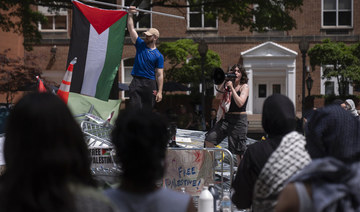TRIPOLI: Seif Al-Islam, the son of slain leader Muammer Qaddafi, wants to “restore the lost unity” of Libya after a decade of chaos and does not exclude standing for the presidency.
He spoke in a rare interview, given to the New York Times at an opulent two-story villa inside a gated compound at Zintan in the west of the North African country.
For years, mystery had surrounded the precise whereabouts of a man wanted for war crimes by the International Criminal Court (ICC).
The 49-year-old, who before 2011 had been seen as his father’s presumed successor, said politicians in the decade since have brought Libyans “nothing but misery.”
“It is time for a return to the past. The country — it’s on its knees ... There’s no money, no security. There’s no life here,” Seif Al-Islam said in his first appearance in years.
After four decades in power, Muammer Qaddafi and his relatives were the target of a popular uprising in 2011.
Three of the dictator’s seven sons were killed, but the fate of Seif Al-Islam was unknown.
He was captured by a Libyan militia in November 2011, days after his father was killed.
Four years later, a Tripoli court sentenced him in absentia to death for crimes committed during the revolt.
The ICC has repeatedly asked for him to be handed over for trial.
Until the interview, Seif Al-Islam had not been seen or heard from since June 2014, when he appeared via video link from Zintan during his trial by the Tripoli court.
Seif Al-Islam said in the interview that he was a free man organizing a political return, and that his former captors “are now my friends.”
He told the paper the militiamen eventually realized he could be a powerful ally.
In recent years, Libya has been split between two rival administrations backed by foreign forces and countless militias.
In October, after forces of the Tripoli-based Government of National Accord (GNA) routed those of eastern military strongman Khalifa Haftar, the two camps agreed a cease-fire in Geneva.
The security situation has been slowly improving since.
A provisional government was agreed in March, and general elections are expected to take place on December 24.
Any possible return by Seif Al-Islam to Libyan politics would face hurdles, including his conviction by the Tripoli court and the ICC warrant for his arrest.
But the Britain-educated son of Muammer Qaddafi seems undeterred, according to the New York Times.
Seif Al-Islam said “he was confident that these legal issues could be negotiated away if a majority of the Libyan people choose him as their leader.”
The paper quoted him as saying: “I’ve been away from the Libyan people for 10 years. You need to come back slowly, slowly. Like a striptease. You need to play with their minds a little.”
Asked if it felt strange to seek shelter in Libyan homes when he was on the run in 2011, he was as enigmatic as some of the opinions expressed in his late father’s ‘Green Book’.
“We’re like fish, and the Libyan people are like a sea for us,” Seif Al-Islam replied.
“Without them, we die. That’s where we get support. We hide here. We fight here. We get support from there. The Libyan people are our ocean.”
Qaddafi’s son wants to restore lost unity of Libya
https://arab.news/cpjj4
Qaddafi’s son wants to restore lost unity of Libya
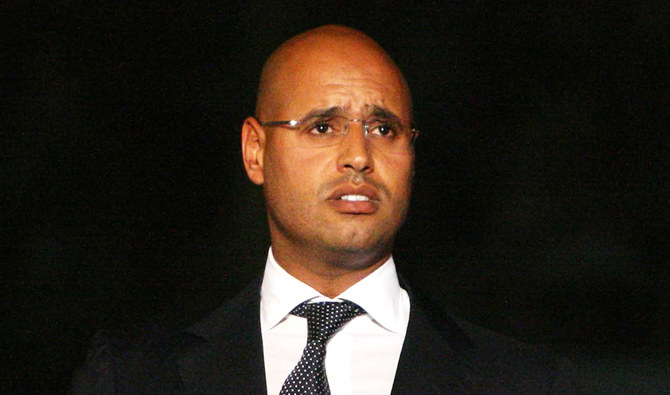
- It is time for a return to the past. The country — it’s on its knees ... There’s no money, no security. There’s no life here. Seif Al-Islam
‘Unlike anything we have studied’: Gaza’s destruction in numbers
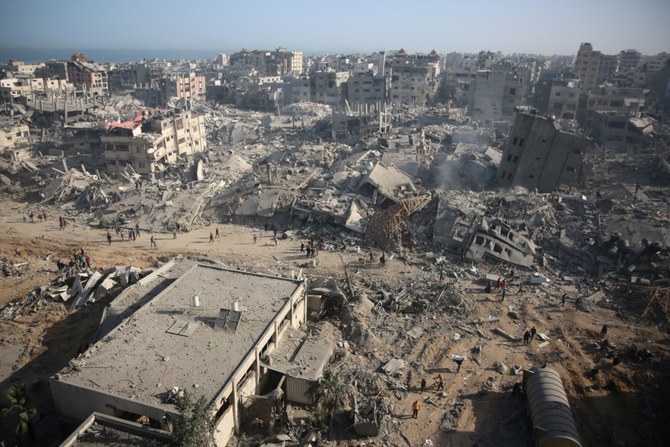
- The level of destruction in northern Gaza has surpassed that of the German city of Dresden, which was firebombed by Allied forces in 1945 in one of the most controversial Allied acts of World War II
Paris: As well as killing more than 34,000 people and causing catastrophic levels of hunger and injury, the seven-month war between Israel and Hamas has also caused massive material destruction in Gaza.
“The rate of damage being registered is unlike anything we have studied before. It is much faster and more extensive than anything we have mapped,” said Corey Scher, a PhD candidate at the City University of New York, who has been researching satellite imagery of Gaza.
As Israel launches an offensive on Rafah, the last population center in Gaza yet to be entered by its ground troops, AFP looks at the territory’s shattered landscape seven months into the war sparked by Hamas’s unprecedented October 7 attack.
Gaza is one of the most densely populated places on the planet, where before the war 2.3 million people had been living on a 365-square-kilometer strip of land.
According to satellite analyzes by Scher and Jamon Van Den Hoek, an associate professor of geography at Oregon State University, 56.9 percent of Gaza buildings were damaged or destroyed as of April 21, totaling 160,000.
“The fastest rates of destruction were in the first two to three months of the bombardment,” Scher told AFP.
In Gaza City, home to some 600,000 people before the war, the situation is dire: almost three-quarters (74.3 percent) of its buildings have been damaged or destroyed.
During the war, Gaza’s hospitals have been repeatedly attacked by Israel, which accuses Hamas of using them for military purposes, a charge the militant group denies.
In the first six weeks of the war sparked by the Hamas attack, which killed more than 1,170 people according to an AFP tally of Israeli official figures, “60 percent of health care facilities... were indicated as damaged or destroyed,” Scher said.
The territory’s largest hospital, Al-Shifa in Gaza City, was targeted in two offensives by the Israeli army, the first in November, the second in March.
The World Health Organization said the second operation reduced the hospital to an “empty shell” strewn with human remains.
Five hospitals have been completely destroyed, according to figures compiled by AFP from the OpenStreetMap project, the Hamas health ministry and the United Nations Satellite Center (UNOSAT). Fewer than one in three hospitals — 28 percent — are partially functioning, according to the UN.
The territory’s largely UN-run schools, where many civilians have sought refuge from the fighting, have also paid a heavy price.
As of April 25, UNICEF counted 408 schools damaged, representing at least 72.5 percent of its count of 563 facilities.
Of those, 53 school buildings have been completely destroyed and 274 others have been damaged by direct fire.
The UN estimates that two-thirds of the schools will need total or major reconstruction to be functional again.
Regarding places of worship, combined data from UNOSAT and OpenStreetMap show 61.5 percent of mosques have been damaged or destroyed.
The level of destruction in northern Gaza has surpassed that of the German city of Dresden, which was firebombed by Allied forces in 1945 in one of the most controversial Allied acts of World War II.
According to a US military study from 1954, quoted by the Financial Times, the bombing campaign at the end of World War II damaged 59 percent of Dresden’s buildings.
In late April, the head of the UN mine clearance program in the Palestinian territories, Mungo Birch, said there was more rubble to clear in Gaza than in Ukraine, which was invaded by Russia more than two years ago.
The UN estimated that as of the start of May, the post-war reconstruction of Gaza would cost between 30 billion and 40 billion dollars.
HRW: Israel attack on Lebanon rescuers was ‘unlawful’
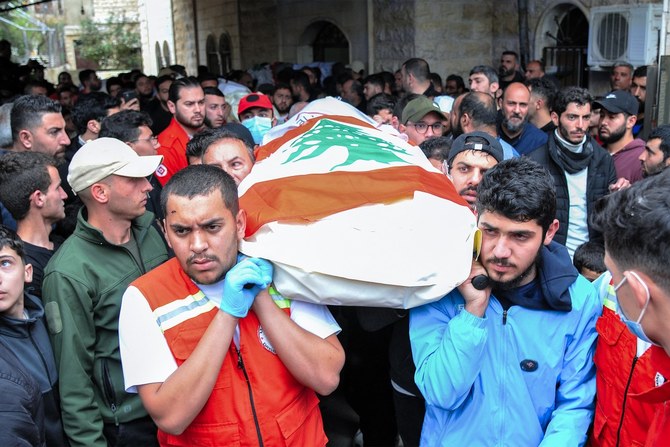
- The rights group urged the United States to “immediately suspend arms sales and military assistance to Israel
Beirut: Human Rights Watch said Tuesday an Israeli strike in Lebanon that killed seven first responders was “an unlawful attack on civilians,” and urged Washington to suspend weapons sales to Israel.
The Israel-Lebanon border area has witnessed near-daily exchanges between the Israeli army and Hamas ally Hezbollah since the Palestinian militant group attacked southern Israel on October 7 sparking war in Gaza.
“An Israeli strike on an emergency and relief center” in the southern village of Habariyeh on March 27 “killed seven emergency and relief volunteers” and constituted an “unlawful attack on civilians that failed to take all necessary precautions,” HRW said in a statement.
“If the attack on civilians was carried out intentionally or recklessly, it should be investigated as an apparent war crime,” it added.
The Israeli military did not immediately comment when contacted by AFP.
But at the time the military said the target was “a military compound” and that the strike killed a “significant terrorist operative” from Jamaa Islamiya, a Lebanese group close to Hamas, and other “terrorists.”
HRW said in the statement that it found “no evidence of a military target at the site,” and said the Israeli strike “targeted a residential structure that housed the Emergency and Relief Corps of the Lebanese Succour Association, a non-governmental humanitarian organization.”
Jamaa Islamiya later denied it was connected to the emergency responders, and the association told AFP it had no affiliation with any Lebanese political organization.
HRW said “the Israeli military’s admission” it had targeted the center in Habariyeh indicated a “failure to take all feasible precautions to verify that the target was military and avoid loss of civilian life... making the strike unlawful.”
The rights group said those killed were volunteers, adding that 18-year-old twin brothers were among the dead.
“Family members... the Lebanese Succour Association, and the civil defense all said that the seven men were civilians and not affiliated with any armed group,” it added.
However, it noted that social media content suggested at least two of those killed “may have been supporters” of Jamaa Islamiya.
HRW said images of weapons parts found at the site included the remains of an Israeli bomb and remnants of a “guidance kit produced by the US-based Boeing Company.”
“Israeli forces used a US weapon to conduct a strike that killed seven civilian relief workers in Lebanon who were merely doing their jobs,” HRW’s Lebanon researcher, Ramzi Kaiss, said.
The rights group urged the United States to “immediately suspend arms sales and military assistance to Israel given evidence that the Israeli military is using US weapons unlawfully.”
Mid-level Israeli team to head to Cairo to assess Hamas position, Israeli official says
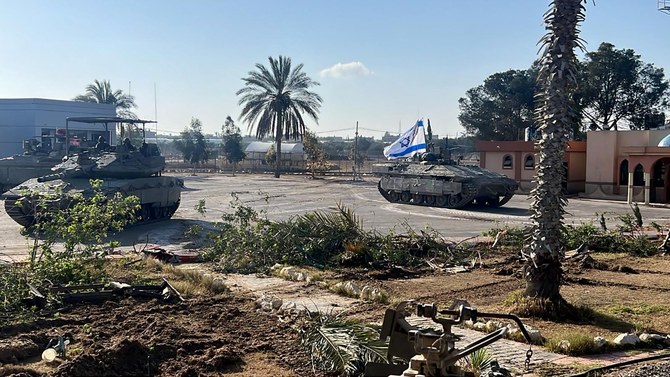
- Current ceasefire proposal is not acceptable to Israel
- Israel military takes control of Rafah crossing, special forces scanning area
- Hamas says Rafah operation aims to undermine ceasefire efforts
JERUSALEM: A team of mid-ranking Israeli officials will travel to Cairo in coming hours to assess whether Hamas can be persuaded to shift on its latest ceasefire offer, a senior Israeli official said, reiterating the current proposal was unacceptable to Israel.
“This delegation is made up of mid-level envoys. Were there a credible deal in the offing, the principals would be heading the delegation,” the official told Reuters, referring to the senior officials from the intelligence services Mossad and Shin Bet who are leading the Israeli side.
The visit to the Egyptian capital will take place hours after Israeli tanks took control of the Palestinian side of the Rafah border crossing between Egypt and Gaza.
Israeli jets have carried out repeated strikes on eastern Rafah, the southern Gaza city where more than 1 million Palestinians displaced by the seven-month war have been sheltering.
Egypt’s state-aligned Al Qahera News TV reported that there were still efforts to contain the escalation between the two sides and said Egyptian officials had asked Israel to stop the Rafah operation immediately.
Hamas issued a statement saying the operation was designed to undermine ceasefire efforts.
The Israeli official, who spoke on condition of anonymity, said Israel’s demonstrated determination to move against Rafah had pushed Hamas into putting out its latest proposal hastily.
The proposal took the basic framework of a proposal from April 27, based around a halt in fighting and a return of some of the more than 130 Israeli hostages in exchange for Palestinian prisoners in Israel, and stretched it to “unacceptable extremes,” the official said.
However, another official said Hamas had agreed to the phased ceasefire and hostage release deal Israel proposed on April 27 with only minor changes that did not affect the main parts of the proposal.
The new demand would not allow Israel to veto the release of specific Palestinian prisoners, including Marwan Barghouti, a leader from the Fatah faction currently serving a life sentence for his role in mounting deadly attacks against Israelis.
“Hamas wants them all to be eligible and for Israel to have no say in the matter,” the official said.
It would also lift restrictions on the import into Gaza of so-called dual use materials that can be used for both civilian and military purposes. “Hamas says these should be allowed in for the rehabilitation of Gaza, but we know that their intention is to manufacture munitions.”
In addition, Hamas was now offering to release only 18 hostages in the first phase of a truce, instead of the 33 who would have been released under previous proposals, with the remainder to come in a subsequent phase.
“That means Israel would get only 18 hostages if it sticks to its refusal to call off the offensive,” the official said.
Rafah crossing closed
A Gaza border authority spokesperson told Reuters the Rafah crossing, a major route for aid into the devastated enclave, was closed because of the presence of Israeli tanks. Israel’s Army Radio had earlier announced its forces were there.
The United States has been pressing Israel not to launch a military campaign in Rafah until it had drawn up a humanitarian plan for the Palestinians sheltering there, which Washington says it has yet to see.
Israel said the vast majority of people had been evacuated form the area of military operations.
Instructed by Arabic text messages, phone calls and flyers to move to what the Israeli military called an “expanded humanitarian zone” around 20 km (12 miles) away, some Palestinian families began trundling away in chilly spring rain.
Some piled children and possessions onto donkey carts, while others left by pick-up or on foot through muddy streets.
As families dismantled tents and folded belongings, Abdullah Al-Najar said this was the fourth time he had been displaced since the fighting began seven months ago.
“God knows where we will go now. We have not decided yet.”
UKMTO receives report two explosions south of Yemen’s Aden
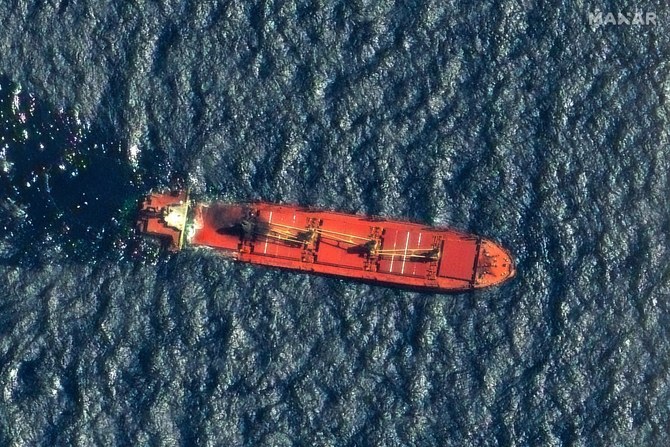
- The Houthi militia that controls the most populous parts of Yemen and is aligned with Iran have staged attacks on ships in the waters off the country for months
Dubai: A merchant vessel passing through the Gulf of Aden off Yemen reported two explosions in “close proximity,” British maritime security agency UKMTO said Tuesday.
The United Kingdom Maritime Trade Operations said the “vessel and all crew are safe,” adding that “authorities are investigating” the blasts south of Yemen’s southern port city of Aden.
UKMTO, which is run by Britain’s Royal Navy, did not provide details on the ship or the nature of attack.
Yemen’s Iran-backed Houthi rebels have launched dozens of drone and missile strikes against ships in the Red Sea and the Gulf of Aden since November.
The Houthis say their campaign is in solidarity with Palestinians amid the Gaza war.
On Friday, they threatened to expand operations targeting Israel-bound shipping to the Mediterranean Sea.
The United States announced an initiative in December to protect Red Sea shipping from Houthi attacks, which have prompted major firms to avoid the route that normally carries 12 percent of global trade.
Since January, the US and Britain have also launched repeated retaliatory strikes on Houthi targets in Yemen.
On Monday, US military forces downed a drone launched by the Houthis over the Red Sea, the US military’s Central Command (CENTCOM) said in a statement.
The drone “presented an imminent threat to US coalition forces and merchant vessels in the region,” CENTCOM said.
Palestinians seek UN General Assembly backing for full membership

- Diplomats say 193-member General Assembly likely to back Palestinian bid
- Others say move could set precedent for others, citing Kosovo and Taiwan as examples
UNITED NATIONS: The United Nations General Assembly could vote on Friday on a draft resolution that would recognize the Palestinians as qualified to become a full UN member and recommend that the UN Security Council “reconsider the matter favorably.”
It would effectively act as a global survey of how much support the Palestinians have for their bid, which was vetoed in the UN Security Council last month by the United States. An application to become a full UN member needs to be approved by the 15-member Security Council and then the General Assembly.
Diplomats say the 193-member General Assembly is likely to back the Palestinian bid. But changes could still be made to the draft after some diplomats raised concerns with the current text, seen by Reuters, that also grants additional rights and privileges — short of full membership — to the Palestinians.
Some diplomats say this could set a precedent for other situations, citing Kosovo and Taiwan as examples.
Israel’s UN Ambassador Gilad Erdan on Monday denounced the current draft General Assembly resolution, saying it would give the Palestinians the de facto status and rights of a state and goes against the founding UN Charter.
“If it is approved, I expect the United States to completely stop funding the UN and its institutions, in accordance with American law,” said Erdan, adding that adoption by the General Assembly would not change anything on the ground.
US CONCERNS
Under US law, Washington cannot fund any UN organization that grants full membership to any group that does not have the “internationally recognized attributes” of statehood. The US halted funding in 2011 for the UN cultural agency (UNESCO)after the Palestinians became a full member.
“It remains the US view that the path toward statehood for the Palestinian people is through direct negotiations,” said Nate Evans, spokesperson for the US mission to the UN
“We are aware of the resolution and reiterate our concerns with any effort to extend certain benefits to entities when there are unresolved questions as to whether the Palestinians currently meet the criteria under the Charter,” he said.
The Palestinians are currently a non-member observer state, a de facto recognition of statehood that was granted by the UN General Assembly in 2012. The Palestinian mission to the UN in New York did not immediately respond to a request for comment on its push for action in the General Assembly.
The Palestinian push for full UN membership comes seven months into a war between Israel and Palestinian militants Hamas in the Gaza Strip, and as Israel is expanding settlements in the occupied West Bank, which the UN considers to be illegal. The United Nations has long endorsed a vision of two states living side by side within secure and recognized borders.
Palestinians want a state in the West Bank, east Jerusalem and Gaza Strip, all territory captured by Israel in 1967.



